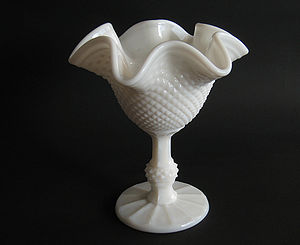Milk glass: Difference between revisions
| Line 15: | Line 15: | ||
==Collectible== |
==Collectible== |
||
Milk glass has a considerable following of collectors.<ref name="collect49">{{cite book|last=Belknap|first=Eugene McCamly|title=Milk glass|publisher=Crown Publishers|year=1949|pages=327|url=http://books.google.com/books?id=3zA1AAAAMAAJ}}</ref> |
Milk glass has a considerable following of collectors.<ref name="collect49">{{cite book|last=Belknap|first=Eugene McCamly|title=Milk glass|publisher=Crown Publishers|year=1949|pages=327|url=http://books.google.com/books?id=3zA1AAAAMAAJ}}</ref> This shows that humans will collect anything. |
||
Glass makers continue to produce both original pieces and reproductions of popular collectible pieces and patterns.<ref name="2007TMGB">{{cite book|last=Chiarenza|first=Frank|coauthors=James Slater|title=The Milk Glass Book|publisher=Schiffer Pub Ltd,|year=2007|edition=illustrated|series=A Schiffer book for collectors|pages=228|isbn=0764306618, 9780764306617|url=http://books.google.com/books?id=xBUOAAAACAAJ}}</ref> |
Glass makers continue to produce both original pieces and reproductions of popular collectible pieces and patterns.<ref name="2007TMGB">{{cite book|last=Chiarenza|first=Frank|coauthors=James Slater|title=The Milk Glass Book|publisher=Schiffer Pub Ltd,|year=2007|edition=illustrated|series=A Schiffer book for collectors|pages=228|isbn=0764306618, 9780764306617|url=http://books.google.com/books?id=xBUOAAAACAAJ}}</ref> And this shows that other humans will always capitalize on groups of humans that can be identified as consumers and given a product. |
||
==Notable manufacturers==<!-- sourced or with WP article please--> |
==Notable manufacturers==<!-- sourced or with WP article please--> |
||
Revision as of 22:45, 23 April 2011
This article needs additional citations for verification. (February 2009) |

Milk glass is an opaque or translucent,[citation needed] milky white or colored glass, blown or pressed into a wide variety of shapes. First made in Venice in the 16th century, colors include blue, pink, yellow, brown, black, and the white that led to its popular name.
History
First made in Venice in the 16th century, colors include blue, pink, yellow, brown, black, and white. 19th-century glass makers called milky white opaque glass "opal glass". The name milk glass is relatively recent. The white color is achieved through the addition of an opacifier, e.g. tin dioxide or bone ash.[1]
Made into decorative dinnerware, lamps, vases, and costume jewelry, milk glass was highly popular during the fin de siecle. Pieces made for the wealthy of the Gilded Age are known for their delicacy and beauty in color and design, while Depression glass pieces of the 1930s and '40s are less so.
Collectible
Milk glass has a considerable following of collectors.[2] This shows that humans will collect anything. Glass makers continue to produce both original pieces and reproductions of popular collectible pieces and patterns.[3] And this shows that other humans will always capitalize on groups of humans that can be identified as consumers and given a product.
Notable manufacturers

- Kanawha Glass Co.
- Fenton Glass Company
- Fostoria Glass Company
- Imperial Glass Company
- Mosser Glass
- Westmoreland Glass Company
References
- ^ Husfloen, Kyle (2007). Antique Trader Antiques & Collectibles 2008 Price Guide (illustrated ed.). 644: Krause Publications. p. 1066. ISBN 0896895319, 9780896895317.
{{cite book}}: Check|isbn=value: invalid character (help)CS1 maint: location (link) - ^ Belknap, Eugene McCamly (1949). Milk glass. Crown Publishers. p. 327.
- ^ Chiarenza, Frank (2007). The Milk Glass Book. A Schiffer book for collectors (illustrated ed.). Schiffer Pub Ltd,. p. 228. ISBN 0764306618, 9780764306617.
{{cite book}}: Check|isbn=value: invalid character (help); Unknown parameter|coauthors=ignored (|author=suggested) (help)CS1 maint: extra punctuation (link)
